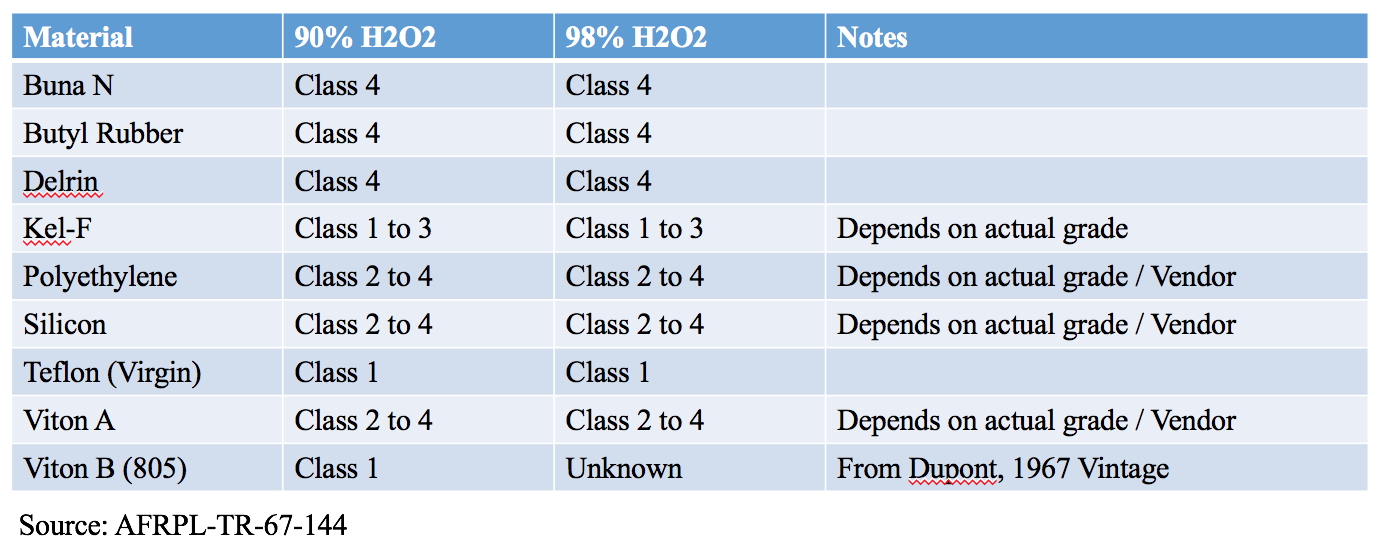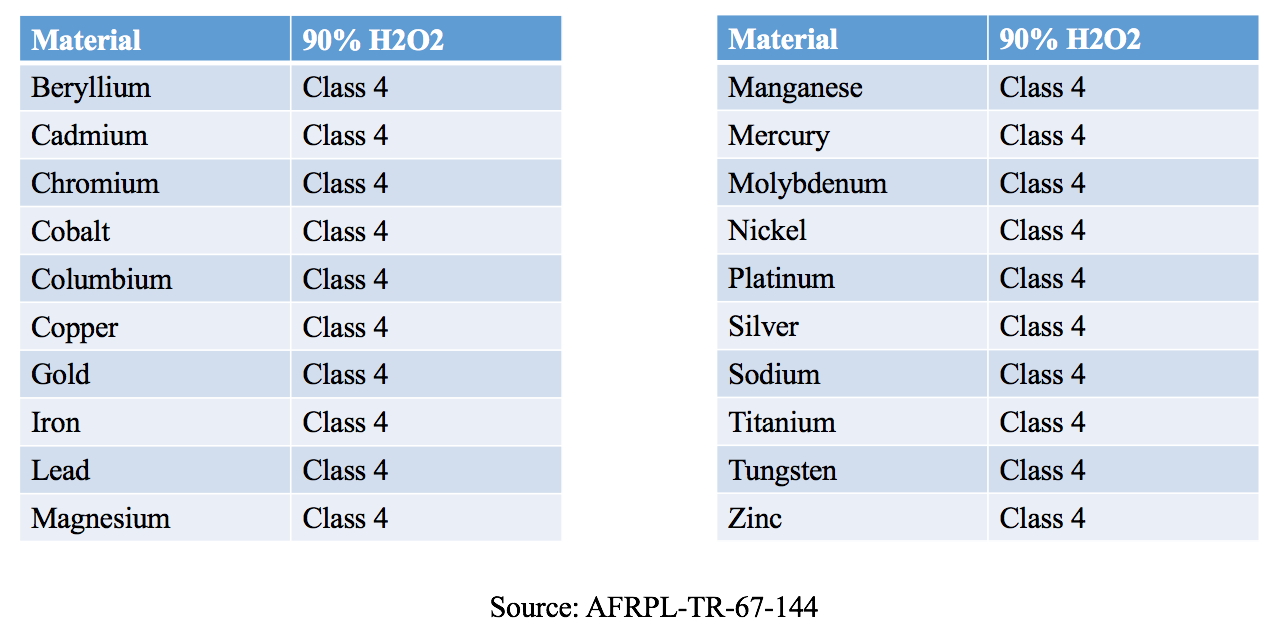Chapter 7:
H2O2 Material Compatibility

• All wetted surfaces should be made of materials that are compatible with hydrogen peroxide. The wetted
area or surface of a part, component, vessel or piping is a surface which is in permanent contact with or is
permanently exposed to the process fluid (liquid or gas).
- Hydrogen Peroxide storability (and more generally, compatibility) is based off of the rate of decomposition when in contact with a given material.
- Hydrogen Peroxide Material compatibility is generally ranked through a class structure.
- Class 1: Materials Satisfactory for Unrestricted use with H2O2 ‒ Class 2: Materials Satisfactory for Repeated Short-Time Contract with H2O2.
- Maximum of 4 hours at 160 F or 1 Week at 70 F.
- Class 3: Materials Satisfactory for Short-Term Contact Only.
- Less than 1 minute at 160 F and 1 hour at 70 F for unpressurized systems. Single use only.
- Class 4: Not recommended for use with H2O2.
- Class 1: Materials Satisfactory for Unrestricted use with H2O2 ‒ Class 2: Materials Satisfactory for Repeated Short-Time Contract with H2O2.
•The class system is only used to provide a relative guide, and is not a perfect system.•Surface finish and surface treatment has a large impact on compatibility.•Most Metals need to be passivated prior to service with HTP.
--> Stainless Steel Compatibility Chart
--> Aluminum Compatibility Chart
--> Seals and Elastomers Compatibility Chart

--> Metals to Avoid

General Material Compatibility Checklist
| Material | Compatibility 10% H2O2 |
Compatibility 30% H2O2 |
Compatibility 50% H2O2 |
Compatibility 100% H2O2 |
|---|---|---|---|---|
| 304 stainless steel | B2 - Good | B2 - Good | B2 - Good | B2 - Good |
| 316 stainless steel | B - Good | B - Good | A2 - Excellent | A2 - Excellent |
| ABS plastic | A - Excellent | N/A | N/A | A - Excellent |
| Acetal (Delrin®) | D - Severe Effect | D - Severe Effect | D - Severe Effect | D - Severe Effect |
| Aluminum | A - Excellent | A - Excellent | A - Excellent | A - Excellent |
| Brass | N/A | N/A | N/A | D - Severe Effect |
| Bronze | B1 - Good | B1 - Good | B1 - Good | B1 - Good |
| Buna N (Nitrile) | D - Severe Effect | D - Severe Effect | D - Severe Effect | D - Severe Effect |
| Carbon graphite | C - Fair | C - Fair | C - Fair | C - Fair |
| Carpenter 20 | C - Fair | B - Good | B - Good | D - Severe Effect |
| Cast iron | C - Fair | B - Good | N/A | B - Good |
| Ceramic Al203 | N/A | N/A | N/A | A - Excellent |
| Ceramic magnet | A - Excellent | A - Excellent | A - Excellent | A - Excellent |
| Copper | D - Severe Effect | D - Severe Effect | D - Severe Effect | D - Severe Effect |
| CPVC | A - Excellent | A - Excellent | A - Excellent | A - Excellent |
| EPDM | A - Excellent | B - Good | B - Good | D - Severe Effect |
| Epoxy | C1 - Fair | B - Good | N/A | A - Excellent |
| Hastelloy-C® | A - Excellent | A - Excellent | A - Excellent | A - Excellent |
| Hypalon® | D - Severe Effect | D - Severe Effect | D - Severe Effect | D - Severe Effect |
| Hytrel® | N/A | N/A | N/A | N/A |
| Kel-F® | A - Excellent | B - Good | A - Excellent | B - Good |
| LDPE | A - Excellent | C2 - Fair | C2 - Fair | C2 - Fair |
| Natural rubber | B - Good | C - Fair | C - Fair | C - Fair |
| Neoprene | D - Severe Effect | D - Severe Effect | D - Severe Effect | D - Severe Effect |
| NORYL® | A2 - Excellent | A2 - Excellent | N/A | A - Excellent |
| Nylon | C1 - Fair | D - Severe Effect | D - Severe Effect | D - Severe Effect |
| Polycarbonate | A2 - Excellent | A2 - Excellent | A2 - Excellent | A - Excellent |
| Polypropylene | A - Excellent | B1 - Good | B1 - Good | B1 - Good |
| PPS (Ryton®) | A - Excellent | A1 - Excellent | N/A | C - Fair |
| PTFE (Teflon®) | A - Excellent | A - Excellent | A - Excellent | A - Excellent |
| PVC | A1 - Excellent | A1 - Excellent | A1 - Excellent | A - Excellent |
| PVDF (Kynar®) | A - Excellent | A - Excellent | A1 - Excellent | A1 - Excellent |
| Silicone | A - Excellent | B - Good | B - Good | B - Good |
| Titanium | A - Excellent | B1 - Good | A - Excellent | B - Good |
| Tygon® | B - Good | B - Good | B - Good | B - Good |
| Viton® | A - Excellent | A - Excellent | A - Excellent | A - Excellent |
Ratings -- Chemical Effect
N/A = Information Not Available. |
Explanation of Footnotes
|

